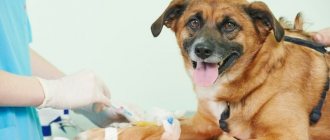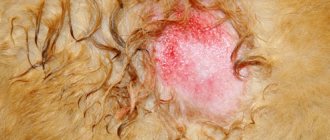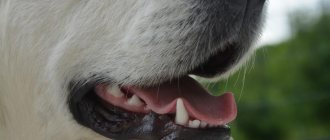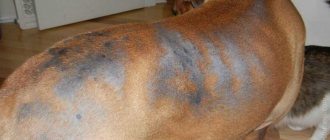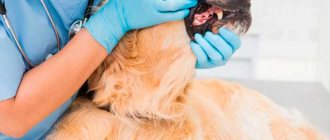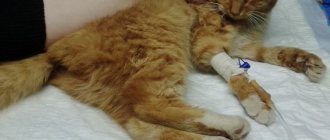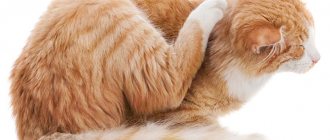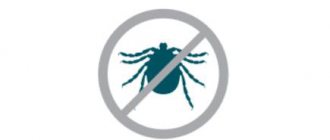Often the cause of a runny nose can be diseases that have nothing to do with the nasopharynx. These include:
- Diseases of the liver, kidneys, intestines, heart. All these pathologies greatly weaken the immune system; viruses and infections begin to attack the body. And he is simply unable to resist the new pathology.
- Diabetes. The disease affects all organs and systems, making the dog vulnerable to infectious diseases. Moreover, rhinitis in this case is difficult to treat.
- Neoplasms in the nasal cavity. Cysts, polyps, tumors - all this interferes with breathing through the nose. Breathing can only be restored through surgery.
- Parasites, fleas. A runny nose can also appear as a result of the activity of parasites living in the animal’s body. Fleas can crawl into your nose, causing itching, sneezing and a runny nose.
- Acquired or congenital changes in the nasal septum. They may appear as a deviated nasal septum, palate, or jaw. Such anomalies prevent the animal from breathing through the nose. Often, against the background of these pathologies, moderate discharge from the nasal cavity appears.
To get rid of a runny nose forever, it is necessary to establish the cause and begin treatment for the underlying disease.
Content
Despite a fairly powerful natural immune system, pets often have to experience health problems similar to human ailments. Experienced dog owners easily recognize the most common symptoms, and they never hesitate to visit a veterinarian. Beginners should know what to do if a dog has rhinitis. If you do not pay attention, you can lead to the most serious problems, leading to a series of troubles with almost all organ systems.
The biggest difficulty at an early stage is determining whether the nasal moisture is normal or just snot. This can be easily checked using a dry white cloth. You need to secure your pet, and then hold your nose with paper for 10-20 seconds. When you remove the tissue, the dog should sneeze. If these are a few small droplets, then everything is within normal limits. But when there is excess mucus on the white surface, especially if it has an unusual color or inclusions of blood, then this is a cause for concern and further action.
Causes of snot in dogs
We list the most common factors leading to nasal discharge. Veterinarians recognize many more causes. For preliminary information, this list will suffice:
| Hypothermia | Short-haired breeds that are walked without overalls especially suffer from this. A negative temperature can only be tolerated for 15 minutes, and then a catastrophic decline in immunity begins. A dog simply catches a cold when thermal regulation is disrupted. The snot will have a clear consistency. If you measure your body temperature with a rectal thermometer, it will show at least 39 degrees, and the next day you will experience sneezing and coughing. |
| Bacteria and viruses | In this case, the discharge will be yellow or green, and sometimes there will be red inclusions from the blood. Over time, thickening occurs, making breathing significantly more difficult. The surface of the nose is dry, and crusts begin to harden around it. The animal continues breathing only through its mouth. |
| Allergic reactions | The immune system malfunctions due to the same factors as in humans. Red vegetables, chemicals, flower pollen, book dust. This dog is very similar to an allergy sufferer. The mucous membrane of the eyes swells, tears constantly flow, coughing and sneezing are observed. |
| Strong odors | Staying near a fire for a long time, the housewife's perfume, new washing powder stored near the animal's sleeping area. All this causes discharge from the nose, which is much more sensitive than the human sense of smell. |
| Foreign body entry | Dogs are very curious, they constantly sniff the grass, children's toys or just the ground. In the process, they are so passionate that they often inhale every little thing. Discharge will come from one nostril, and the pet will show that something is bothering him. He will lie down on the floor and then sort of rub his nose with his paw. Some breeds instinctively shake their heads in an attempt to get rid of debris. |
| Tumors and polyps in the nose | This will be immediately indicated by bloody snot, as well as a drop in the dog’s general tone. She will also try to free the nasal passage, put her paws on her muzzle, and even lightly hit her head on the doorframe. |
| Damage | If the nasal sinus is damaged, then the snot will come constantly. This is noticeable even in puppyhood. This also includes various developmental pathologies, bone fractures after accidents, etc. |
| Worm infestations | Sometimes a secondary symptom of various diseases is a wide variety of nasal discharge. Indirectly, this can be caused by helminthic infestations and severe problems with the organs of the hematopoietic circle. In general, any decrease in immunity automatically leads to drying out of the outer part of the nose with the subsequent appearance of discharge. |
Possible diseases and their symptoms
You can diagnose snot in a dog yourself. They are usually accompanied by:
- sneezing;
- rubbing the nose with paws;
- nasal discharge of various types.
At first, the consistency of the discharge is liquid. Over time, the snot thickens. They dry out in the nose, forming crusts. Because of this, it becomes difficult for the dog to breathe; it breathes through its mouth.
If rhinitis develops as a separate disease, then the general condition of the animal, as a rule, is not disturbed. He has a good appetite. In acute form, with timely treatment, rhinitis goes away within a week. If the disease has developed into a chronic form, exacerbations will periodically occur. The dog may be depressed and lose weight.
If a runny nose occurs as a symptom of other pathological conditions, it may be present for a long time. To make a correct diagnosis, it is better to consult a veterinarian and also observe the nature of the nasal discharge and what other symptoms are present.
If the snot becomes thick and acquires a greenish tint, then the process is already quite advanced and bacterial microflora has become attached. The dog is sneezing and keeps trying to scratch its nose. If there is an infection, the animal's temperature may rise, the mucous membranes of the nasopharynx may become hyperemic and swell.
If the discharge appears against the background of an allergic reaction, then the discharge will be not only from the nose, but also from the eyes. Other allergy symptoms:
- itching;
- sneezing;
- skin rashes;
- swelling.
If a foreign body gets into the nose, the animal will do its best to show that something is bothering it: rub its nose with its paws, actively shake its head, try to sneeze out. If it flows from only one nostril, you can suspect the presence of a neoplasm. Bloody discharge may appear. And the further the disease progresses, the more often they will appear. As the formation grows, deformation of the bridge of the nose and muzzle occurs. Ichor may appear in the snot. Changes in the shape of the nose and muzzle are also possible due to injury.
Severe infections are accompanied by the development of additional symptoms:
- weakness;
- heat;
- lack of appetite;
- thirst;
- vomit.
You should not let the presence of snot in a dog take its course. Often this symptom is just the tip of the iceberg of dangerous diseases. Therefore, it is better to carry out diagnostics in the clinic.
The main symptoms of a runny nose in dogs
The owner must exercise extreme care to promptly detect and begin to treat this disease correctly. The main symptoms observed (in addition to nasal discharge):
- Breathing is very difficult, sometimes only in a certain position.
- The animal snores on one of the sides or in any position.
- With its paws the pet is trying to improve its position.
- Crusts collect around the nose (you can’t peel them off, just soak them).
- Appetite and sense of smell decrease. Getting a dog to eat at least something is very difficult.
- Sneezing and coughing may be associated.
How to treat snot in a dog at home
The owner must immediately go through all the options described above in his head, and then try to understand what caused the problem with the pet’s body. He should also perform a simple preventive inspection using a bright LED flashlight. Sometimes foreign bodies can be seen independently; they can be literally on the edge. Then use tweezers to remove them. In other cases, you need to consult a doctor. Also try to observe the animal very carefully. Heavy breathing and a complete loss of appetite already indicate serious health problems.
If activity remains, and the only symptom is clear snot from the nose, then you can follow the following instructions yourself:
- Try to remove all the crusts by first soaking them in warm boiled water. Pharmacy hydrogen peroxide is suitable for the same purposes. After removal, be sure to soften the dry nose with Vaseline or some kind of oil-based ointment.
- There are cotton swabs for babies with a limiter. You can try to remove excess secretions with them.
- For purulent discharge, you can crush a streptocide tablet and sprinkle the resulting powder on the outer part of the nostril.
- Drops for humans are not suitable for dogs, except for herbal, oil-based varieties. But you can try to use them only if you are completely congested.
- Douching is strictly prohibited, otherwise the animal may choke. Their respiratory tract is structured differently from that of humans.
- You can instill decoctions of disinfectant herbs into the nostrils. For example, it could be calendula or oak bark. Dogs have a very strong immune system, and this will be a great help.
- Do not feed your pet for a long time, but heat the water before serving.
- Sometimes you may even need to give up walks or reduce their time to 10-15 minutes.
Helping your pet before visiting the clinic
- Cover your dog's eyes with your palm and shine a flashlight into his nose. Carefully examine the mucous membranes (is there any swelling, redness, or narrowed nasal passages). We have already written above what to do if a runny nose appears due to a foreign body stuck in the nostril. But what you shouldn’t do is try to wash a stuck object with a jet or drip, even carefully, drops into the spout (the danger is the same - you can push the debris even deeper);
- remove all dirt around the nostrils and from the mirror of the nose with a gauze swab dipped in lukewarm water or chamomile infusion;
- drip anandin or maxidin solution (0.15%), 1-2 drops into each nostril of a small dog and 3 drops if the dog weighs more than 40 kg. These are complex drops that are active against bacteria and viruses, relieve swelling and inflammation, accelerate tissue healing - the drugs are soft and safe. Repeat 2-3 times a day, remembering to first clear the nose of exudate;
A dog, like any other animal, is susceptible to various diseases. In this article we will tell you what causes a runny nose in a dog, what are the symptoms of the disease, and, of course, what to do and how to treat your pet with such an illness.
[Hide]
What is rhinitis?
Rhinitis is an inflammation of the mucous membranes of the nose; it can be either an independent disease or a sign of other pathologies, for example, infection or allergies. There are several types of disease:
- Spicy. The symptoms are pronounced, the condition occurs against the background of infection with a virus or bacteria.
- Chronic. Appears as a consequence of prolonged exposure to adverse environmental factors or as a complication of the acute form.
- Vasomotor. The reaction occurs at the level of reflexes.
- Allergic. The mucous membranes are sensitive to allergens in the external environment (pollen, dust, etc.).
Many people put rhinitis in dogs and a runny nose on the same level, but in fact, nasal discharge is only a symptom of the disease. This type of disease is called catarrhal rhinitis.
Main predisposing factors
A runny nose in dogs can be the result of many different diseases. In particular, even neoplasia , as well as idiopathic lymphoplasmacytic and fungal rhinitis, . But there are still many more real reasons.
Much worse is the fact that mucous discharge from the nasal cavity may well indicate some severe systemic disorders in the body. In this case, depression, hyperthermia, and nosebleeds often develop. But in such cases, a runny nose never develops suddenly: the pathology evolves gradually, against the backdrop of a constant deterioration in the dog’s health. It’s quite difficult not to notice this. Major systemic pathologies that can cause this effect include:
- coagulopathy;
- vasculitis;
- arterial hypertension;
- pneumonia;
- bronchitis;
- laryngitis;
- tracheitis, etc.
It should be noted that the nature and type of nasal discharge can be extremely helpful in making a diagnosis. In particular, fungal rhinitis is characterized by the appearance in the exudate of many whitish “lumps”, which are both pieces of mycelium (mycelium of the pathogen) and fragments of collapsing tissues of the nasopharynx.
Never, under any circumstances, use nasal drops intended for humans to “treat” your pet. This way you can easily poison your pet or cover up the symptoms!
Common causes of rhinitis in dogs
To better understand the variety of predisposing factors, you need to familiarize yourself with the table below, which describes the main reasons.
| Name of pathology | Pathogens, predisposing factors |
| Viral rhinitis | Carnivore plague |
| Rhinitis of bacterial origin | Bordetella bronchiseptica Pasteurella multocida |
| Rhinitis of fungal origin | Aspergillus fumigatus Fungi of the genus Penicillium Rhinosporidium seeberi Cryptococcus neoformans |
| Parasitic pathologies | Pneumonyssus caninum Eucoleus [Capillaria] boehmi |
| Autoimmune diseases (it is not always possible to prove their presence), since any pathology of this type manifests itself extremely vaguely | Nasopharyngeal idiopathic stenosis Idiopathic granulomatous rhinitis Hyperplastic rhinitis (to which Irish wolfhounds are particularly susceptible) |
| Negative environmental factors | Smoke, dust In small breed dogs, rhinitis often appears as a result of severe hypothermia The action of caustic and irritating substances, which are often household chemicals |
| Allergic rhinitis | Plant pollen Household chemicals, cosmetics, care products Feed components Medicines |
But even this list is not half complete. Therefore, when diagnosing, a veterinarian has to be extremely careful and pay close attention to any factors, even if they seem insignificant.
About the important features of the secreted exudate
Serous nasal discharge is the most uncharacteristic, as it is noticed in the initial stages of almost all types of nasopharyngeal diseases. Subsequently, it almost always turns into catarrhal, purulent or another form, from which the root cause of what is happening can be judged with a greater degree of confidence. This happens because at first the bacterial, viral or fungal microflora does not yet have time to “settle in” to the proper extent, and therefore there are still no signs of a specific infection.
Catarrhal-purulent (mucous discharge of a greenish or greenish-yellow color) nasal discharge is the most common and often indicates bacterial contamination of the nasopharyngeal organs. It can also indicate almost any systemic bacterial infection of the body. Often purulent discharge from the nose is the result of a serious injury or foreign body. This is also indicated by blood, which in such cases is abundantly mixed with “normal” secretions. Note that primary infections that cause a purulent inflammatory process in the thickness of the nasal cavity and sinuses are quite rare in dogs.
In addition, attention should be paid to where exactly the exudate is coming from: from one or both nostrils. Thus, unilateral discharge is often associated with neoplasia, fungal rhinitis or foreign body entry, inflammatory processes caused by periodontal diseases. Bilateral discharge is typical for systemic disorders, neoplasia, fungal rhinitis, idiopathic lymphoplasmacytic and allergic types. However, in the last two cases, with equal probability, only unilateral discharge of exudate may be present, so these signs alone will clearly not be enough for an accurate diagnosis.
Causes of runny nose in dogs
The condition occurs for many reasons, most of them are similar to human ones:
- Cold. Animals, just like people, react to hypothermia and drafts. If the dog walked for a long time in bad weather, suddenly left a hot apartment into the cold, slept on a cold floor, the body’s thermoregulation is disrupted, a runny nose, fever, sometimes sneezing, coughing, and fever occur.
- Infection or virus infection. In this case, the first two to three days the discharge will be abundant, liquid and transparent. Next, the green (yellow) snot will become thicker, and the dog will begin to grunt. Your pet may also suffer from conjunctivitis, stool disorders, and vomiting.
- Allergic rhinitis is a reaction of the immune system to an irritant. Most often it is dust, pollen, specific scents, chemicals or shampoos. Clear snot flows, accompanied by redness of the eyes, coughing, and sneezing. Diarrhea and difficulty breathing occur less frequently.
- Aggressive odors can cause a short-term runny nose. The pet will scratch its face with its paws, sneeze, and turn away.
- Foreign object in the respiratory tract. Dogs explore the world through their sense of smell, so it's not surprising that they might accidentally inhale a small object. The dog will try to get rid of it, sneezing, rubbing his nose, shaking his head. Discharge will be observed only from one nostril; if it is damaged, blood may be present in the mucus.
- The presence of neoplasms in the nasal passages (polyps, cysts, tumors). In this case, breathing is difficult, the animal will sniffle, grunt, breathe through its mouth, often rub its face, and pain will appear.
- Mechanical damage, congenital pathologies (fracture of the nose or jaw, cleft palate).
Breeds with a flattened muzzle, such as Shar-Peis and Pugs, are more likely to suffer from a runny nose.
Diagnostic techniques
A competent external examination and medical history data, collected, among other things, from the words of the animal owner are very important. Routine laboratory tests (complete blood count, serum chemistries, and urinalysis), coagulation and blood pressure testing, and nasal radiography are all necessary to rule out systemic pathologies, cancer, and foreign bodies in the nasal cavity. Microscopic examination of the exudate is practically useless except in cases where infection with Eucoleus [Capillaria] boehmi is suspected.
In addition, it is not recommended to use exudative material for sowing it on nutrient media: in fact, it is useless. The fact is that in the nasal cavity of even a completely healthy dog you can always find both fungi and bacteria (and occasionally even pathogenic forms are found). Simply put, dozens of types of microorganisms can grow in the form of a culture, and it will be unrealistic to understand which of them caused the inflammation.
Much more important and objective is serology, that is, analysis of blood serum for the presence of antibodies. In the presence of an infection of viral or bacterial origin, it will be possible (in approximately 70% of cases) to accurately determine the specific pathogen. Empirical antimicrobial treatment is strongly not recommended! Simply put, do not start treatment with antibiotics immediately, even if you suspect the bacterial nature of his disease. But even to this rule there are a couple of exceptions.
Bordetella bronchiseptica or Pasteurella multocida (cases of their detection are quite rare) can very quickly lead to the death of the animal , and therefore, even if their presence is suspected, immediate initiation of antimicrobial therapy is recommended. In addition, the indication for such radical measures is profuse purulent discharge from the nasal cavity.
Symptoms of rhinitis
While describing the possible causes of the problem, we briefly mentioned the signs of a particular disease. Symptoms may vary, but general features of the disease can be identified:
- presence of nasal discharge (intensity and consistency vary);
- difficulty breathing (you can hear wheezing, snoring in your sleep);
- the dog constantly tries to help itself by touching its nose with its paws;
- sneezing;
- deterioration of smell.
Apathy, poor appetite, and tearfulness also often appear. With a prolonged runny nose, crusts form on the nose. Possible increased body temperature, diarrhea, nausea.
Symptoms
In addition to sneezing and nasal discharge, the following symptoms develop:
- The dog licks his nose and tries to warm it with his paws. Clear liquid flows from the nose.
- With an allergic rhinitis, exudate flows from both nostrils. When the animal approaches the stimulus, the intensity of the discharge increases and lacrimation occurs. In some cases, food allergies develop, an additional symptom of which is dermatitis.
- When a foreign object enters the nostril, unilateral discharge is observed, sometimes with blood.
- Chronic runny nose is characterized by the formation of crusts of drying exudate around the nasal mirror.
- The animal sniffles, tries to breathe through its mouth, and snores in its sleep.
Crusts with chronic runny nose. - With a long runny nose, the discharge changes color. At first they become cloudy and white. If the inflammatory process becomes chronic, first yellow and then green snot appears.
- Appetite worsens.
- A cough appears and the dog wheezes.
- Body temperature rises.
How to treat runny nose in dogs at home?
You can treat snot in a dog at home, but a doctor must still prescribe it. He will determine the cause of rhinitis, prescribe medications in accordance with it, and, if necessary, take additional tests. Before the doctor arrives, the owner can do the following:
- A flashlight will be a great help to examine your pet. Assess the presence of discharge, its color and consistency, and intensity. Observe your dog for other symptoms. You will tell the doctor about all this.
- Clear your nose of mucus and crusts. To do this, wrap gauze or a cotton pad around your finger and, if necessary, moisten it with warm water.
- You can give your dog a chamomile decoction or treat the nasal passages with it. Taking an infusion of the herb internally soothes, applying it to the mucous membranes relieves itching and has an antiseptic effect.
- Make sure that the animal does not aggravate its condition by being in a draft or frost. Walking your dog when you have a runny nose is minimal.
- Offer your pet to drink more, preferably warm water. The food remains familiar.
The doctor will prescribe medication. Depending on the provoking factor, it may be necessary to exclude the allergen from the diet or the external environment, take antihistamines, remove a foreign body from the passages, or surgically remove tumors. But in most cases, a runny nose is caused by a cold, then nasal medications, warming and rinsing the sinuses are most often used to relieve the symptom.
Nasal drops
The most famous nasal drops for a runny nose for dogs are Maxidin. Doctors allow you to give them yourself, the main thing is to take into account the instructions for use. The drug has an antiviral and immunomodulatory effect. Used in the treatment of plague, parvovirus, enteritis, and helminthiasis. They help with skin diseases and are often prescribed as a preventive measure. If you start giving Maxidin at the first appearance of snot, you can prevent the spread of infection. Drop the solution 2 drops 3 times a day.
Another well-known remedy is Anandin. An intranasal drug used to treat rhinitis and conjunctivitis; accordingly, it should be instilled into the nose or eyes, depending on the problem. For a runny nose, it is recommended to use the product three times a day, the dose depends on the weight of the animal, ranging from 1 to 4 drops. Long-term therapy is addictive, so the duration of the course is no more than 14 days.
Warming up
One of the effective methods of facilitating an animal's breathing is warming up. You need to take a sock or scarf, heat salt or sand in a dry frying pan, pour it into the fabric. The compress is applied to the bridge of the nose for 3-4 minutes. Remember, it is better to do short-term but frequent procedures. If home treatment is not enough, physical therapy can be provided through a veterinary clinic.
Washing
It is necessary to rinse your dog's nose when he has a runny nose. Firstly, it cleanses the airways and removes mucus. Secondly, it is a preventive measure against the spread of infection. You can use pharmaceutical remedies or traditional methods, including:
- Soda solution, prepared at the rate of 1 tbsp. water for 1 tsp. sodium carbonate. The liquid should be warm. On the advice of a doctor, you can add a few drops of iodine to the mixture.
General rules and methods of treatment
Treatment directly depends on what caused the runny nose. After all, colds, allergies, or rhinitis associated with the presence of a tumor are treated differently. The veterinarian always has the final say.
General rules
Before you start giving the animal any medications or performing procedures, you need to ensure comfortable conditions:
- place the pet in a warm place, do not let it lie on the cold floor;
- do not stay in a cool room;
- eliminate drafts;
- the humidity level in the room should be within 60% so that the dog’s nasal mucosa does not dry out; excessive humidity is also undesirable;
- Reduce walking outside to a minimum;
- Give plenty of clean warm water.
During treatment, it is necessary to regularly check the dog's temperature, even if the animal is externally active. There are cases that snot appears as a harbinger of some serious illness.
Self-medication is prohibited! Use any medications only with the approval of a veterinarian.
Nasal drops
There are many types of drops that have different compositions and have different effects.
If your dog has clear, watery nasal discharge due to a cold, you can use the following drops:
- Derinat;
- Pinosol;
- Eucasept.
These are herbal oil-based products. You need to instill 2-3 drops into each nostril twice a day for 1-2 weeks.
You can use Anandin drops. The drug has an anti-inflammatory, bactericidal, tonic effect. These drops are suitable for both the nose and eyes. It is recommended to apply nasal drops three times a day. The number of drops is determined by the dog's weight. 1-4 drops are usually used in each nostril. It is not recommended to be treated with Anandin for more than 2 weeks. The drug becomes addictive and becomes ineffective.
To strengthen the immune system, you can use Maxidin drops. Inject 1-2 drops into each nostril 2-3 times a day.
Warming up
In case of a cold, if there is no purulent discharge or bleeding, as well as nasopharyngeal injuries, you can help the animal by warming it up. Place a bag of warm salt, sand or buckwheat on the bridge of your nose. Leave for 10-15 minutes. It is recommended to repeat the procedure three times a day.
Washing
To quickly free the nasal passages from accumulated secretions and prevent them from thickening, it is recommended to rinse the nose. To do this, use special solutions heated to body temperature, which are injected into the nasal passages using a rubber bulb or a syringe without a needle. Carefully inject the solution into each nasal passage in small portions, waiting for it to flow out. The mucus will come off and the animal may begin to sneeze.
To rinse your nose you can use:
- saline 0.9%;
- boric acid no more than 3%;
- furatsilin (1 tablet dissolved in 200 ml of water);
- soda 1%;
- dixidin 1%, diluted with water to 0.5%;
- potassium permanganate.
Antibiotics
If there is snot that is accompanied by a bacterial infection, the doctor will prescribe antibiotics.
Typically, drugs with a broad spectrum of action are used:
- Penicillin;
- Cefatoxime;
- Cefix;
- Amoxicillin and others.
For fibrotic rhinitis, it is recommended to administer antibiotics from the sulfonamide group.
Immunotherapy and vitamin therapy
In order for the body to recover faster during the treatment process, the dog needs to strengthen its immune system. For these purposes, the dog is given immunomodulatory agents and vitamins. They are especially recommended for viral infections.
Effective drugs:
- Ribotan - administered intramuscularly once 0.5-2 ml for 5 days.
- Immunofan - injected into the withers area once a day for 5-7 days.
- Cycloferon - 5 injections in total: 2 days in a row, 1 injection, then every other day. The dosage depends on the weight of the animal.
To replenish vitamins, it is recommended to enrich the diet with foods containing vitamins A, C, E, and group B.
Folk remedies
When a dog has a cold, sometimes folk methods are used for the dog’s nose. Decoctions that effectively relieve inflammation and cleanse the nasal passages:
- chamomile;
- sequences;
- coltsfoot;
- violets.
Juices:
- onion;
- beet;
- carrot.
It is recommended to dilute them with warm boiled water first.
Why does a dog ride on its butt? Learn about the causes and treatment of possible diseases.
The rating of holistic class dog food, characteristics of dry and canned food can be seen in this article.
On the page, read about why your dog's breath smells and how to eliminate the unpleasant odor.
Prohibited actions
Not all measures to eliminate snot in a dog can benefit the animal.
Forbidden:
- the use of vasoconstrictor drops (Naphthyzin, Galazolin), they dry out the nasal mucosa;
- warming with salt, sand and other means in the presence of green and thick snot.
Treatment of allergic rhinitis
If your dog's nasal discharge is the result of an allergy, you must first remove the allergen's exposure to the body.
After this, you can give the animal an antihistamine:
- Ketotifen;
- Suprastin;
- Cetrin.
What to do if your dog grunts?
If there are no obvious symptoms of a cold or allergy, but the dog sniffles or snores in its sleep, it is necessary to find out the cause of the phenomenon and begin appropriate treatment:
- Polyps and other neoplasms. Small growths may not be noticed; only difficulty breathing will indicate their presence. When large tumors appear, the teeth will begin to loosen, frequent nosebleeds will occur, and in the later stages the muzzle will become deformed. The problem cannot be solved with pills; surgical intervention is necessary.
- Adenovirus is one of the common and dangerous infections, one of the symptoms of which is rhinitis. The discharge will be cloudy in color and a frequent cough will begin. The disease is only combated by antibiotics and supportive care.
- Allergic rhinitis can only be treated under medical supervision. If the allergen can be excluded, this must be done; if not, for example, a reaction to pollen occurs, the veterinarian will prescribe a course of treatment with antihistamines. In this case, the owner will only need to rinse the pet’s nose.
The occurrence of rhinitis is a signal to the breeder that the pet’s immune system is weakened and needs to be strengthened. Often in dogs of small breeds the body’s protective properties do not cope. They need to be stimulated with vitamins (A, E, C, group B), the veterinarian can additionally prescribe immunomodulators (Immunofan, Immunal, Cycloferon, Gamavit).
Video: how to treat a runny nose (rhinitis) and snot in a dog at home?
Home Remedies for Dog Stuffy Nose
If your dog is only experiencing a temporary and mild case of nasal congestion, you may be able to treat the problem at home. Just make sure you contact your veterinarian if his symptoms worsen or the congestion doesn't go away after a day or two.
A few of the best home remedies and strategies for caring for a dog with a stuffy nose include:
- Gently massage your dog's nose to loosen the mucus and allow it to drain . This will likely make your dog feel good, just as it does for you when you blow your nose.
- Use a nasal aspirator to suck out excess mucus . Be very careful when doing this and make sure you are only inserting the tip of the aspirator into your pet's nasal passages. Be sure to thoroughly clean the aspirator after use, and do not use the same aspirator on your dog that you use on your child.
- Let your dog lie on the bathroom floor while you take a hot shower . The steam will help moisten her nasal passages and potentially allow mucus to drain.
- Use a humidifier to increase the amount of moisture in the air inside your home . Confining your dog to a small room with a humidifier will likely produce better results. Be especially careful to clean your humidifier regularly.
Prevention of runny nose in dogs
In most cases, inflammation of the mucous membranes of the nose is caused by a cold. It can be easily prevented if you follow these recommendations:
- Provide the animal with proper care: a balanced diet and sufficient exercise. Remember that if you feed your pet natural food, it is better to give additional mineral complexes. If you prefer dry food, buy professional brands. Always consider your friend's breed; Jack Russell Terriers and Corgis require different levels of exercise.
- Walk your animal regularly (at least 2 times a day), with the exception of bad weather.
- Avoid hypothermia at home and outside. In the apartment, the dog should have a bed; it is located in a place protected from drafts. The dog is not taken for a walk after bathing; in the cold season, insulated overalls are worn.
- Hardening helps strengthen the immune system and improves the general condition of the body. The main thing is to gradually increase the time you walk in the cold.
- Do not ignore annual vaccinations, they strengthen the immune system and protect against the most dangerous infections. It is also advisable to take your dog to the veterinarian once a year and undergo general tests.
- A runny nose can be a symptom of a viral disease that was contracted from another animal. Try to protect your pet from contact with sick individuals.
Following these recommendations will make your pet's body stronger. If you are all faced with rhinitis, do not delay treatment, do not allow the disease to progress.
There is probably not a single person on Earth who does not know about such a problem as a runny nose. A constant runny nose, a burning sensation and dryness of the mucous membranes, and the inability to breathe air freely are just some of the symptoms of a runny nose or rhinitis, as the disease is otherwise called. But a runny nose happens not only to us, but also to our four-legged pets - dogs. And of course, animals suffer from the inability to breathe well just as much as people.
Prevention
Rhinitis in dogs is mainly caused by various infections and colds. To protect your pet, you must follow simple rules for preventing runny nose in dogs:
- Balanced diet. Food should be enriched with nutrients and a complex of vitamins.
- Active lifestyle. It is necessary to spend a lot of time with your dog in the fresh air. The exception is bad weather conditions.
- Beware of hypothermia. The dog should be protected in every possible way from exposure to unfavorable conditions that can lead to colds.
- Timely treatment of pathologies.
- Timely vaccination (vaccination calendar).
- Avoid contact with sick animals.
Particular attention should be paid to pets with infections and diseases with a history of illness.
It is important to accustom your pet to the influence of unfavorable conditions from childhood. Hardening is a simple and affordable method. But there is no need to keep the puppy in the cold for a long time. Hardening should take place gradually.
If treatment at home does not bring a positive result, then it is necessary to show the pet to a veterinarian; how to treat, only he knows. Only proper care and a professional approach to therapy will help your dog quickly recover from an illness.
Causes of dog runny nose
There are plenty of reasons why a dog has a runny nose and the animal sneezes a hundred times a day. Here are the most common ones:
- Hypothermia.
If the dog is wet and frozen in the rain; I walked outside for a long time, where the temperature was below zero; was bathed but not dried; slept in a draft, a runny nose may easily appear due to a violation of thermoregulation. In this case, the discharge from the nose will be transparent, there may be an increase in body temperature (up to 39-39.5 degrees) and fever, sneezing and coughing;
Bacterial and viral infections.
If rhinitis is provoked by the introduction of viruses or bacteria into the body, the initially clear nasal discharge will turn purulent (yellow or greenish, sometimes with red blood streaks) a few days after the onset of the disease, and its consistency will change from liquid to thick. In addition to nasal discharge, your dog may have watery eyes, and sometimes vomiting and diarrhea. The animal is depressed, refuses food and sometimes water. Dry crusts may appear on the nose, which, together with a runny nose, will make breathing difficult, causing the dog to breathe heavily, possibly even through the mouth;
Allergy.
The dog’s immune system can perceive as an enemy, for example, house dust, pollen, care products (shampoos, sprays, etc.). In addition to clear discharge from the nasal passages, the animal will likely experience sneezing, swelling of the mucous membranes, coughing, eye inflammation and lacrimation. In some situations, animals with allergies even experience stomach and intestinal disorders;
How to treat?
Standard treatment consists of two stages:
- If crusts have formed on your dog's nose,
apply a cotton pad soaked in saline or hydrogen peroxide to them and carefully remove them after they soften. - The second step is rinsing the nasal cavity
with a solution of Furacilin (1 tablet dissolved in a glass of warm water) or soda, with Aqua Maris.
Helping your pet is primarily aimed at eliminating the root cause. A runny nose in a dog: how to treat different types of nasal discharge is shown in the table.
| Type of runny nose | Treatment |
| 1. Allergic | The dog has a runny nose and is sneezing, what to treat if the cause is an allergic reaction? First of all, you should identify the allergen and protect the animal from it (foods, household chemicals, pollen, etc.), and also select the appropriate ones. The nasal passages are washed with Furacilin solution. As an additional measure to relieve allergic reactions, it is worth considering switching to |
| 2. Caused by infection (rhinitis) | Treatment of rhinitis in a dog begins with rinsing the nose with saline solution. At the second stage, cold drops for dogs are used. For each nasal passage, the dosage is 1-2 drops of Derinat, Pinosol (if the discharge is thick) or Galazolin (5-6 drops). If rhinitis was caused by an infection, it is necessary to begin treatment immediately. To strengthen the immune system, use Thymogen nasal drops (1-8 drops depending on the size of the animal) |
| 3. Caused by foreign body | If a runny nose is caused by a foreign object, it is necessary to remove it from the nasal passage. This procedure is carried out by a veterinarian. After extraction, Maxidin solution is instilled into the nostril. |
| 4. Caused by pathology (cleft palate, etc.) | A runny nose, which is a consequence of such pathologies, cannot be cured. The only way is surgery and elimination of the defect. If the operation is successful, the runny nose will gradually go away without the use of medications. |
What to do if your dog has a runny nose, what medications to take? The course is prescribed only by a veterinarian after examination and diagnosis, because the cause of the pet’s illness may be
Attention!
A runny nose can be caused by many reasons, so you should not self-treat.
